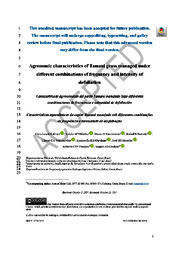Agronomic characteristics of Tamani grass managed under different combinations of frequency and intensity of defoliation.
Agronomic characteristics of Tamani grass managed under different combinations of frequency and intensity of defoliation.
Summary: Background: Management strategies may affect plant growth and herbage characteristics. Thus, understanding its impact may help to define appropriate management. Objective: To evaluate the effect of different defoliation intensities and frequencies on the structural characteristics, biomass components and the potential use of NDVI (normalized difference vegetation index) in pastures with Megathyrsus maximus cv. BRS Tamani. Methods: A randomized block design in a 2x3factorial arrangement was adopted, with two defoliation frequencies (85 and 95% of interception of photosynthetically active radiation (IPAR) and three defoliation intensities (residual leaf area index (LAIr) of 0.8, 1.3 and 1.8). Results: The frequency of defoliation affected the pre-defoliation leaf area index, height, total harvestable forage biomass (HTFB), and harvestable leaf blade (HGLB), with greater values for pastures managed at 95% of IPAR. The effect of intensity of defoliation was observed for the HTFB and HGLB variables, where pastures with lesser LAIr presented greater biomass values. Pastures managed at 95% of IPAR and higher LAIr reached the level of saturation of the normalized difference vegetation index more quickly. Pastures managed under the combination of 95% IPAR and LAIr of 0.8 showed greater production of harvestable green stem biomass and harvestable dead forage biomass. The combination of 95% of IPAR with LAIr of 0.8 or 1.8 enabled a greater number of new live leaves when compared to pastures with 85% of IPAR. Conclusions: Tamani grass must be managed with a frequency of defoliation of 95% of the interception of photosynthetically active radiation, maintaining a residual leaf area index between 0.8 and 1.3. Resumo: Antecedentes:Estratégias de manejo pode afetar o crescimento das plantas e as 87características da pastagem. Assim, o entendimiento do impacto pode ajudar a definir 88manjeos mais adequados. Objetivo:Avaliar o efeito de diferentes intensidades e 89frequências de desfolhamento sobre as características estruturais, componentes da 90biomassa e o potencial de uso do NDVI (índice de vegetação de diferença normalizada) em pastagens com Megathyrsus maximuscv. BRS Tamani. Métodos:Adotou-se o delineamento de blocos casualizados em esquema fatorial 2x3, com duas frequências de 93desfolhação (85 e 95% de interceptação da radiação fotossinteticamente ativa (IPAR) e três intensidades de desfolhação (índice de área foliar residual (LAIr) de 0,8, 1,3 e 1,8). Resultados:A frequência de desfolha afetou o índice de área foliar pré-desfolha, altura, biomassa forrageira total colhível (HTFB), e lâmina foliar colhível (HGLB), com maiores 97valores para pastagens manejadas com 95% de IPAR. O efeito da intensidade de desfolha 98foi observado para as variáveis HTFB e HGLB, onde pastagens com menor LAIr 99apresentaram maiores valores de biomassa. As pastagens manejadas com 95% de IPAR e 100maior LAIr atingiram o nível de saturação do índice de vegetação de diferença 101normalizada mais rapidamente. As pastagens manejadas com uma combinação de 95% IPAR e LAIr de 0,8 apresentaram maior produção de biomassa de colmo verde e biomassa de forragem morta colhível. A combinação de 95% de IPAR com LAIr de 0,8 ou 1,8 possibilitou maior número de novas folhas vivas quando comparado a pastagens com 85% 105de IPAR. Conclusões:O capim Tamani deve ser manejado com uma frequência de 106desfolha de 95% da interceptação da radiação fotossinteticamente ativa, mantendo um 107índice de área foliar residual entre 0,8 e 1,3.
Publication year: 2024
Types of publication: Journal article
Unit: Embrapa Goats & Sheep
Observation
Some of Embrapa's publications are published as ePub files. To read them, use or download one of the following free software options to your computer or mobile device. Android: Google Play Books; IOS: iBooks; Windows and Linux: Calibre.
Access other publications
Access the Agricultural Research Database (BDPA) to consult Embrapa's full library collection and records.
Visit Embrapa Bookstore to purchase books and other publications sold by Embrapa.

